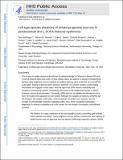| dc.contributor.author | Fieblinger, Tim | |
| dc.contributor.author | Graves, Steven M. | |
| dc.contributor.author | Sebel, Luke E. | |
| dc.contributor.author | Alcacer, Cristina | |
| dc.contributor.author | Plotkin, Joshua L. | |
| dc.contributor.author | Gertler, Tracy S. | |
| dc.contributor.author | Chan, C. Savio | |
| dc.contributor.author | Heiman, Myriam | |
| dc.contributor.author | Greengard, Paul | |
| dc.contributor.author | Cenci, M. Angela | |
| dc.contributor.author | Surmeier, D. James | |
| dc.date.accessioned | 2016-05-09T16:24:40Z | |
| dc.date.available | 2016-05-09T16:24:40Z | |
| dc.date.issued | 2014-10 | |
| dc.date.submitted | 2014-04 | |
| dc.identifier.issn | 2041-1723 | |
| dc.identifier.uri | http://hdl.handle.net/1721.1/102436 | |
| dc.description.abstract | The striatum is widely viewed as the fulcrum of pathophysiology in Parkinson’s disease (PD) and L-DOPA-induced dyskinesia (LID). In these disease states, the balance in activity of striatal direct pathway spiny projection neurons (dSPNs) and indirect pathway spiny projection neurons (iSPNs) is disrupted, leading to aberrant action selection. However, it is unclear whether countervailing mechanisms are engaged in these states. Here we report that iSPN intrinsic excitability and excitatory corticostriatal synaptic connectivity were lower in PD models than normal; L-DOPA treatment restored these properties. Conversely, dSPN intrinsic excitability was elevated in tissue from PD models and suppressed in LID models. Although the synaptic connectivity of dSPNs did not change in PD models, it fell with L-DOPA treatment. In neither case, however, was the strength of corticostriatal connections globally scaled. Thus, SPNs manifested homeostatic adaptations in intrinsic excitability and in the number but not strength of excitatory corticostriatal synapses. | en_US |
| dc.language.iso | en_US | |
| dc.publisher | Nature Publishing Group | en_US |
| dc.relation.isversionof | http://dx.doi.org/10.1038/ncomms6316 | en_US |
| dc.rights | Article is made available in accordance with the publisher's policy and may be subject to US copyright law. Please refer to the publisher's site for terms of use. | en_US |
| dc.source | PMC | en_US |
| dc.title | Cell type-specific plasticity of striatal projection neurons in parkinsonism and L-DOPA-induced dyskinesia | en_US |
| dc.type | Article | en_US |
| dc.identifier.citation | Fieblinger, Tim, Steven M. Graves, Luke E. Sebel, Cristina Alcacer, Joshua L. Plotkin, Tracy S. Gertler, C. Savio Chan, et al. “Cell Type-Specific Plasticity of Striatal Projection Neurons in Parkinsonism and L-DOPA-Induced Dyskinesia.” Nat Comms 5 (October 31, 2014): 5316. | en_US |
| dc.contributor.department | Massachusetts Institute of Technology. Department of Brain and Cognitive Sciences | en_US |
| dc.contributor.department | Picower Institute for Learning and Memory | en_US |
| dc.contributor.mitauthor | Heiman, Myriam | en_US |
| dc.relation.journal | Nature Communications | en_US |
| dc.eprint.version | Author's final manuscript | en_US |
| dc.type.uri | http://purl.org/eprint/type/JournalArticle | en_US |
| eprint.status | http://purl.org/eprint/status/PeerReviewed | en_US |
| dspace.orderedauthors | Fieblinger, Tim; Graves, Steven M.; Sebel, Luke E.; Alcacer, Cristina; Plotkin, Joshua L.; Gertler, Tracy S.; Chan, C. Savio; Heiman, Myriam; Greengard, Paul; Cenci, M. Angela; Surmeier, D. James | en_US |
| dc.identifier.orcid | https://orcid.org/0000-0002-6365-8673 | |
| mit.license | PUBLISHER_POLICY | en_US |
